Alioth, Epsilon Ursae Majoris (ε UMa), is the brightest star in the constellation Ursa Major (the Great Bear). It has an apparent magnitude of 1.77 and lies at a distance of 82.6 light years from Earth. It is the brightest of the seven stars that form the Big Dipper, one of the best-known asterisms in the northern sky. Alioth forms the Big Dipper’s handle with Mizar and Alkaid.
Star type
Alioth has the stellar classification A1III-IVp kB9, indicating a white or blue-white giant or subgiant star with a peculiar (“p”) spectrum. The “kB9” suffix in the star’s spectral class refers to the presence of the calcium K line, representative of the spectral type B9. However, the star’s spectrum is mostly consistent with class A.
Alioth has a mass 2.91 times that of the Sun and a radius 4.29 times solar. With a surface temperature of 8,908 K, it shines with a luminosity 104.4 times that of the Sun. The star has an estimated age of around 300 million years. It spins at 33 km/s and has a rotation period of 5.1 days.
Alioth is the brightest magnetic chemically peculiar class A star in the sky, followed by Mahasim (Theta Aurigae) and Cor Caroli (Alpha2 Canum Venaticorum). Its spectrum is consistent with an Alpha2 Canum Venaticorum variable star. As the brightest MCP star and one with by far the largest angular diameter, Epsilon UMa is often a target of studies.
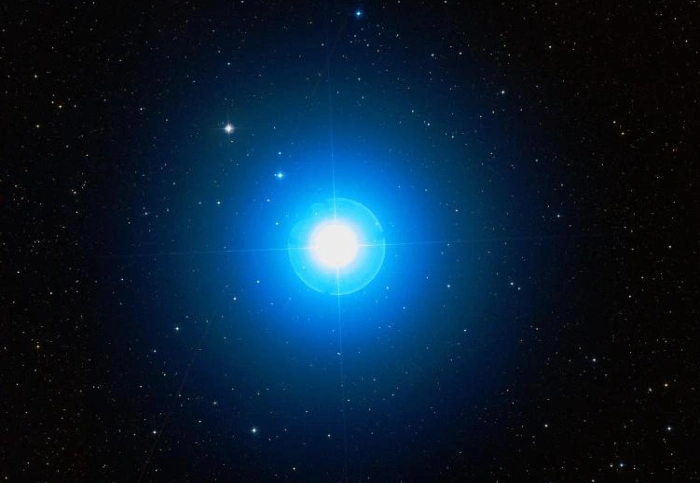
Alioth (Epsilon Ursae Majoris), image credit: ESO/Digitized Sky Survey 2 (CC BY 4.0)
Alpha2 Canum Venaticorum variables are chemically peculiar stars of the spectral class B8p to A7p, typically still on the main sequence. These stars have strong magnetic fields and prominent strontium, silicon or chromium spectral lines. Their spectral lines, magnetic fields and brightness vary, and the periods of the variations correspond to the stars’ rotation periods.
Alpha2 Canum Venaticorum variables were named after the prototype for this class of stars, known by the proper name Cor Caroli. Cor Caroli (Alpha2 CVn) is the brightest star in the constellation Canes Venatici (the Hunting Dogs). It is located in the same area of the sky as Ursa Major, just under the handle of the Big Dipper.
Other relatively bright stars in this class include Alpheratz (Alpha Andromedae) in the constellation Andromeda, Alpha Doradus in Dorado, Alrescha (Alpha Piscium) in Pisces, Nashira (Gamma Capricorni) in Capricornus, and Mesarthim (Gamma Arietis A) in Aries.
Alioth’s magnetic field separates different elements in the star’s hydrogen supply in its core. The star’s axis of rotation is positioned at an angle to its magnetic axis, and the different elements are spun into regions that come in and out of our line of sight as the star rotates. These elements react differently at different frequencies of light as the star spins. As a result, we see the star’s spectral lines fluctuate over a period of 5.1 days.
Alioth’s rotational and magnetic poles are positioned at almost a 90-degree angle to one another. The abundance of oxygen is about 100,000 times greater around the magnetic equator than near the magnetic poles, and chromium is more densely concentrated in a band positioned at a right angle to the equator.
Alioth has a very weak magnetic field compared to other variable stars in this class. Its magnetic field is about 15 times weaker than Cor Caroli‘s, but still about 100 times stronger than the Earth’s.
The star Alioth was long suspected to be a spectroscopic binary system. Some astronomers even suggested that it may have more than one companion or a large planet orbiting it. In 1913, Ludendorff proposed that the star was a spectroscopic binary, and in 2011, Roberts identified a possible companion at a separation of 0.11 arcseconds. However, more recent observations with the Navy Precision Optical Interferometer (NPOI) and other instruments did not identify any companions.
In 2023, astronomers used the Navy Precision Optical Interferometer to measure the angular diameter of 33 stars, including Alioth. They found a diameter of 1.644 ± 0.020 milliarcseconds and derived a physical radius of 4.29 solar radii for the star.
Facts
Alioth is one of the seven bright Ursa Major stars that form the Big Dipper, the most recognizable asterism in the northern celestial hemisphere. The other six stars that form the bright star pattern are Alkaid (Eta Ursae Majoris), Mizar (Zeta Ursa Majoris), Megrez (Delta Ursae Majoris), Phecda (Gamma Ursae Majoris), Dubhe (Alpha Ursae Majoris), and Merak (Beta Ursae Majoris).
Alioth, Mizar and Alkaid form the Big Dipper’s handle, and Megrez, Phecda, Merak and Dubhe form the bowl. The asterism is known by many other names in different cultures, including the Plough, the Great Wagon, and the Saucepan.
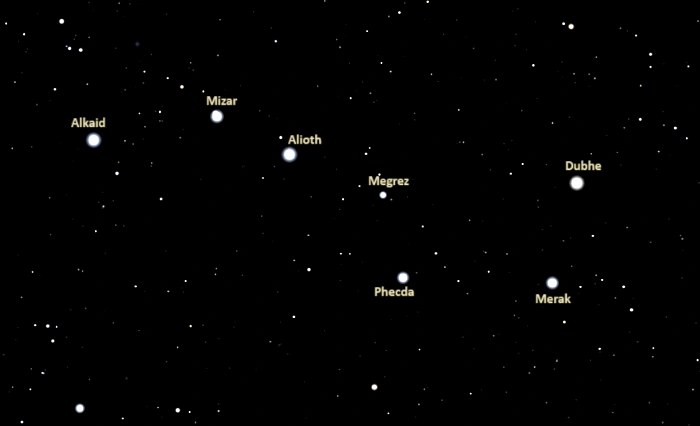
Big Dipper stars, image: Stellarium
Alioth is, on average, the 32nd brightest star in the night sky. It is about as bright as Alnitak, the 31st brightest star and one of the three stars of Orion’s Belt. The two stars are only slightly fainter than Alnair in Grus, Alnilam in Orion, and Miaplacidus in Carina, and they just outshine Mirfak in Perseus, Dubhe in Ursa Major, and Regor in Vela.
Dubhe, the second brightest star in Ursa Major, is only imperceptibly fainter than Alioth. Shining at magnitude 1.79, it appears equally bright as Alioth to the unaided eye.
Alioth is a member of the Ursa Major Moving Group (Collinder 285), a stellar association that includes a number of bright stars, including most of those that form the Big Dipper. (Alkaid and Dubhe are the only exceptions.)
These stars are believed to have a common origin and share common velocities in space. All the stars are thought to have formed about 300 million years ago. The core of the group lies approximately 80 light years away. The brighter stream members outside Ursa Major include Menkalinan (Beta Aurigae) in the constellation Auriga, Skat (Delta Aquarii) in Aquarius, Gamma Leporis in Lepus, Zeta Boötis in Boötes, Alphecca (Alpha Coronae Borealis) in Corona Borealis, and Zhou (Beta Serpentis) in Serpens.
Alioth is listed as one of the 58 navigational stars, along with its Big Dipper neighbours Dubhe (Alpha Ursae Majoris) and Alkaid (Eta Ursae Majoris). The stars selected for use in the field of celestial navigation are both bright and easy to identify because they either belong to a prominent asterism or are located near a recognizable pattern. Alioth is both bright enough to be visible even from light-polluted areas and easy to identify because it is a part of a familiar asterism, the Big Dipper.
Alioth has the Greek letter designation Epsilon, not Alpha, even though it is Ursa Major’s brightest star. When German uranographer Johann Bayer assigned Greek letter designations to stars in his star atlas Uranometria (1603), he mostly followed the magnitude class rule, assigning the letters Alpha and Beta to any first magnitude stars in a constellation.
However, Bayer did not always assign the letters strictly in order of brightness. In Ursa Major, he named the stars from west to east. For this reason, Alioth is designated Epsilon Ursae Majoris even though it is the constellation’s brightest star. The Alpha designation went to Dubhe, the second brightest star in Ursa Major and the westernmost star of the Big Dipper. Merak, which got the designation Beta, is only the fifth brightest star in the constellation.
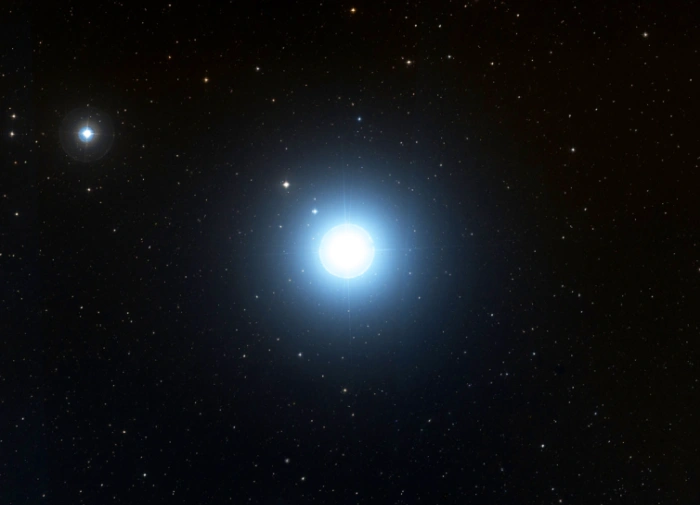
Alioth in Ursa Major. Image created using the Aladin Sky Atlas software from the Strasbourg Astronomical Data Center and DSS (Digitized Sky Survey) data. DSS is one of the programs of STScI (Space Telescope Science Institute). Credit: Roberto Mura (CC BY-SA 4.0)
Name
The name Alioth (pronunciation: /ˈæliɒθ/) is derived from the Arabic alyat al-hamal, meaning “the sheep’s fat tail.” Some sources suggest that it was corrupted from the Arabic al-jaun, meaning “the black horse (or bull),” and that it shares the etymology with the name Alcor.
The name Alioth was officially approved for Epsilon Ursae Majoris A by the International Astronomical Union’s (IAU) Working Group on Star Names (WGSN) on June 30, 2016.
The Chinese know the star as the Fifth Star of Northern Dipper (北斗五), referring to the Chinese asterism Northern Dipper (北斗), which corresponds to the Big Dipper. The Chinese also call Alioth Yù Héng (玉衡), or the Star of Jade Sighting-Tube.
The star’s Hindu name is Añgiras (Angiras), after a Vedic sage mentioned by some sources as one of the Saptarishi (seven rishis or sages). Añgiras was said to teach divine knowledge and mediate between gods and humans. He was considered to be the first of the fire gods, or Agni-devas.
In the Arabic-speaking world, Alioth, Mizar and Alkaid (the stars of the Great Bear‘s tail) represented mourners gathered around a bier formed by Megrez, Phecda, Dubhe and Merak (the stars of the Big Dipper’s bowl).
The constellation represented a funeral procession, with Alioth, Mizar and Alkaid representing the children of Al Na’ash, who met his end at the hands of Al Jadi, represented by Polaris. The slow motion of the Big Dipper stars around the north celestial pole represented the children of Al Na’ash circling Al Jadi, wanting vengeance.
Location
Alioth is very easy to find because it is part of one of the best known asterisms in the night sky. It is the third star of the Big Dipper‘s handle, appearing the closest to the bowl. It is noticeably brighter than most of its Big Dipper neighbours.
The stars of the Big Dipper’s handle can be used to find several bright deep sky objects. The famous Pinwheel Galaxy (Messier 101) forms a triangle with Alkaid and Mizar. The large face-on spiral galaxy has an apparent magnitude of 7.86 and can be seen in small and medium telescopes on a very clear night.
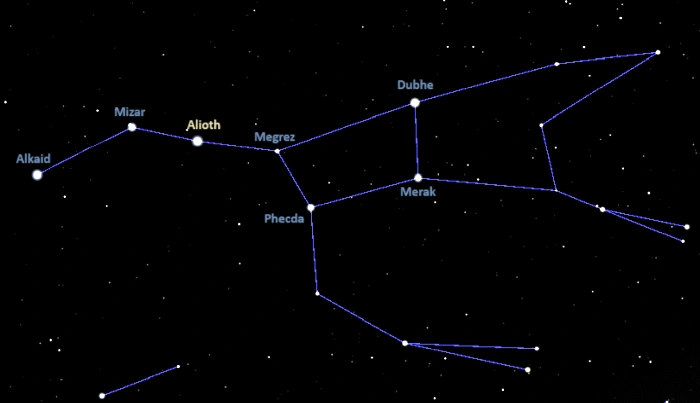
The location of Alioth (Epsilon Ursae Majoris), image: Stellarium
The bright Whirlpool Galaxy (Messier 51) and Sunflower Galaxy (Messier 63) appear in the region between Alkaid and Cor Caroli, the brightest star in Canes Venatici. The spiral galaxies Messier 106 and the Cat’s Eye Galaxy (Messier 94) appear in the same area.
The asterism Messier 40 (Winnecke 4) appears close to Megrez, one of the inner stars of the Big Dipper’s bowl.

Deep sky objects near the Big Dipper’s handle, image: Stellarium
The stars of the Big Dipper’s handle can be used to find two exceptionally bright stars, Arcturus and Spica. Arcturus, Alpha Boötis, is the brightest northern star and the fourth brightest star in the sky, while Spica, Alpha Virginis, is the 16th brightest star and the luminary of the constellation Virgo.
Arcturus and Spica can be found by following the arc of the Dipper’s handle away from the bowl. Arcturus is the first bright star that appears along this imaginary line and Spica, the second. Arcturus lies in the constellation Boötes (the Herdsman) and Spica in Virgo (the Maiden).
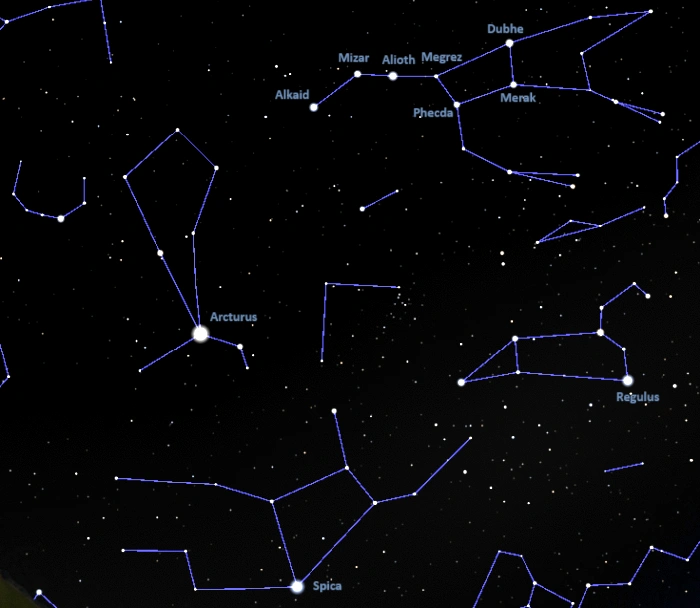
The Big Dipper, Arcturus, Spica and Regulus, image: Stellarium
Constellation
Alioth is located in the constellation Ursa Major. It is one of the stars in the bear’s tail, the closest one to its rear end.
The Great Bear is one of the ancient constellations listed by the Greek astronomer Ptolemy of Alexandria in his Almagest in the 2nd century CE. In Greek mythology, it is associated with Callisto, a nymph turned into a bear by Zeus’ jealous wife Hera.
Ursa Major is the largest northern constellation and the third largest of all 88 constellations, after Hydra and Virgo. It stretches across 1,280 square degrees of the far northern sky. With seven of its bright stars forming the Big Dipper, it is one of the best-known northern constellations.
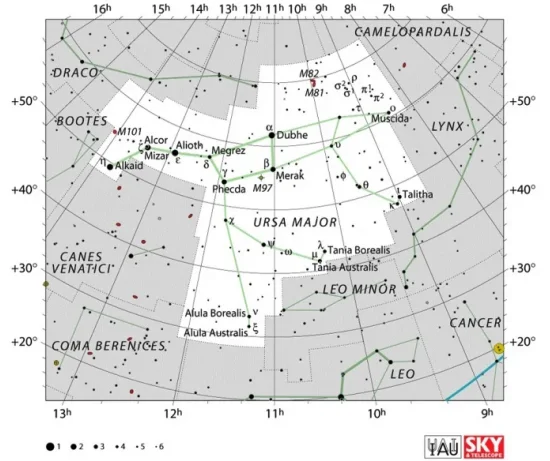
Ursa Major constellation map by IAU and Sky&Telescope magazine (Roger Sinnott & Rick Fienberg) (CC BY 3.0)
Notable stars in Ursa Major include the orange giants Dubhe (Alpha Ursae Majoris) and Psi Ursae Majoris, the hot blue main sequence star Alkaid (Eta Ursae Majoris), the red giant Tania Australis (Mu Ursae Majoris), the A-type main sequence stars Mizar (Zeta Ursae Majoris), Alcor (80 Ursae Majoris), Merak (Beta Ursae Majoris), Phecda (Gamma Ursae Majoris) and Megrez (Delta Ursae Majoris), and the yellow bright giant Muscida (Omicron Ursae Majoris).
The constellation also hosts Chalawan (47 Ursae Majoris), a Sun-like star with three orbiting planets, the orange dwarf HIP 57274, also with three extrasolar planets, and the contact binary star system W Ursae Majoris, a prototype for a class of variable stars known as the W Ursae Majoris variables.
Ursa Major is also home to the red dwarf Lalande 21185, the fourth nearest star system to the Sun, after Alpha Centauri, Barnard’s Star, and Wolf 359.
The Great Bear constellation contains many well-known deep sky objects. Famous galaxies within its borders include the Pinwheel Galaxy (M101), Bode’s Galaxy (M81), the Cigar Galaxy (M82), and the barred spiral galaxies Messier 108 and Messier 109. The constellation also hosts the bright planetary nebula Messier 97, also known as the Owl Nebula. These objects can be located using the bright stars of the Big Dipper.
The Big Dipper stars are circumpolar from most locations in the northern hemisphere and can be seen throughout the year. The best time of the year to observe them is during the month of April, when Ursa Major is high above the horizon in the early evening. The entire constellation is visible from locations north of the latitude 30° S.
The 10 brightest stars in Ursa Major are Alioth (Epsilon UMa, mag. 1.77), Dubhe (Alpha UMa, mag. 1.79), Alkaid (Eta UMa, mag. 1.86), Mizar (Zeta UMa, mag. 2.04), Merak (Beta UMa, mag. 2.37), Phecda (Gamma UMa, 2.438), Psi Ursae Majoris (mag. 3.01), Tania Australis (Mu UMa, mag. 3.06), Talitha (Iota UMa, mag. 3.14), and Theta Ursae Majoris (mag. 3.166).
Alioth – Epsilon Ursae Majoris
| Spectral class | A1III-IVp kB9 |
| Variable type | Alpha2 Canum Venaticorum (α2 CVn) |
| U-B colour index | +0.02 |
| B-V colour index | -0.02 |
| Apparent magnitude | 1.77 |
| Absolute magnitude | -0.2 |
| Distance | 82.6 ± 0.4 light years (25.3 ± 0.1 parsecs) |
| Parallax | 39.51 ± 0.20 mas |
| Radial velocity | -12.70 ± 0.2 km/s |
| Proper motion | RA: +111.91 ± 0.23 mas/yr |
| Dec.: -8.24 ± 0.19 mas/yr | |
| Mass | 2.91 M☉ |
| Luminosity | 104.4 ± 9.3 L☉ |
| Radius | 4.29 R☉ (4.08 – 4.48 R☉) |
| Temperature | 8,908 ± 24 K |
| Age | 300 million years |
| Surface gravity | 3.59 cgs |
| Rotational velocity | 33 km/s |
| Rotation | 5.1 days |
| Metallicity | +0.00 dex |
| Constellation | Ursa Major |
| Right ascension | 12h 54m 01.9628322770s |
| Declination | +55° 57′ 35.225204126” |
| Designations | Alioth, Epsilon Ursae Majoris, ε Ursae Majoris, ε UMa, 77 Ursae Majoris, HD 112185, HR 4905, HIP 62956, SAO 28553, FK5 483, BD+56°1627, AG+56 909, AAVSO 1249+56, PPM 33769, PLX 2964.00, GC 17518, GCRV 7722, RAFGL 1584, CEL 4168, CNS5 3183, CSV 101344, GEN# +1.00112185, GSC 03845-01190, HGAM 620, Renson 32580, JP11 2330, UBV 11641, UBV M 18813, uvby98 100112185, IRC +60222, PMC 90-93 342, N30 2976, ROT 1909, SKY# 23986, WEB 11163, IRAS 12518+5613, 2MASS J12540170+5557349, TD1 16542, TIC 150387644, TYC 3845-1190-1, GCRV 7722, Gaia DR2 1576683529448755328, Gaia DR3 1576683529448755328, CCDM J12540+5558AB, WDS J12540+5558AB |